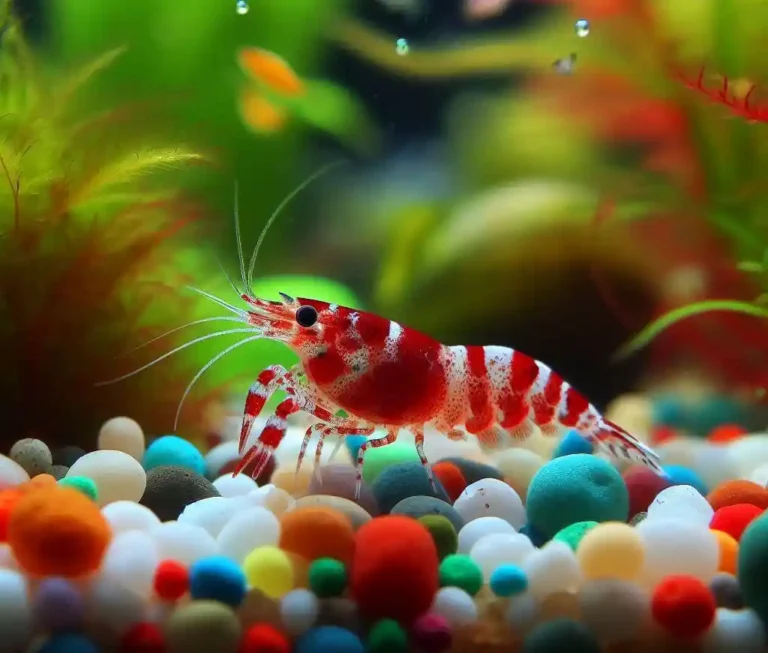Betta Fish Laying on Side: Common Reasons and Remedies
Betta Fish Laying on Side: Have you noticed your betta fish lying on its side at the bottom of the tank, looking lethargic and unwell?
This can be a worrying sight for any betta owner, and it’s natural to wonder what’s causing this unusual behavior.
In this article, we’ll explore the common reasons why your betta fish might be laying on its side, from minor issues like constipation or swim bladder problems to more serious health concerns like infections or diseases.
Betta Fish Laying on Side: A Quick Guide

Why is my betta fish laying on its side?
- Swim bladder problems
- Constipation
- Infections and diseases
- Water quality issues
- Stress and anxiety
What can I do to help my betta fish?
- Treat swim bladder issues with Epsom salt baths and dietary changes
- Prevent constipation with a varied diet and regular water changes
- Use antibiotics and antifungal treatments for infections
- Maintain good water quality through regular water changes and monitoring
- Reduce stress with environmental enrichment and a peaceful tank environment
The Swim Bladder Blues: Understanding Swim Bladder Issues
What causes swim bladder issues in betta fish?
- Genetic predisposition: Some betta fish breeds are more prone to swim bladder issues due to their genetic makeup.
- Diet: A diet high in air-filled foods, such as bloodworms, can cause gas to build up in the swim bladder.
- Infections: Bacterial or fungal infections can cause inflammation and damage to the swim bladder.
- Injury: Physical trauma to the swim bladder can cause it to rupture or become damaged.
Symptoms of swim bladder issues in betta fish
- Laying on their side or swimming erratically
- Difficulty swimming or staying afloat
- Loss of appetite or lethargy
- Visible signs of distress, such as rapid breathing or labored swimming
How to treat swim bladder issues in betta fish
- Epsom salt baths: Adding Epsom salt to the water can help reduce inflammation and alleviate symptoms.
- Dietary changes: Feeding a balanced diet that is low in air-filled foods can help prevent swim bladder issues.
- Antibiotics: In cases of infection, antibiotics may be necessary to clear up the infection.
- Surgery: In severe cases, surgical intervention may be necessary to repair or remove the damaged swim bladder.
Constipation in Betta Fish: Causes, Symptoms, and Solutions

Causes of Constipation in Betta Fish
- Diet: A diet high in processed foods, low in fiber, and lacking in variety can lead to constipation.
- Lack of exercise: Betta fish that don’t get enough exercise may experience constipation due to a lack of muscle tone.
- Water quality: Poor water quality, including high levels of ammonia, nitrite, and nitrate, can cause constipation.
- Stress: Stress can cause digestive issues, including constipation, in betta fish.
Symptoms of Constipation in Betta Fish
- Laying on their side: Constipated betta fish may lay on their side, as they may have difficulty swimming or maintaining their buoyancy.
- Lethargy: Constipated betta fish may become lethargic, losing interest in food and activities.
- Loss of appetite: Constipation can lead to a decrease in appetite, as the betta fish may experience discomfort or pain while eating.
- Visible signs of distress: Constipated betta fish may exhibit visible signs of distress, such as rapid breathing, labored swimming, or erratic behavior.
Solutions for Constipation in Betta Fish
- Dietary changes: Feed a varied diet that includes high-fiber foods, such as spirulina or algae, to promote digestive health.
- Increase exercise: Provide plenty of swimming space and toys to encourage exercise and stimulate digestion.
- Water changes: Regular water changes can help maintain good water quality and reduce the risk of constipation.
- Stress reduction: Reduce stress by providing a peaceful environment, plenty of hiding places, and a consistent routine.
Infections and Diseases: Identifying and Treating the Culprits
Common Infections and Diseases in Betta Fish
- Bacterial Infections: Bacterial infections, such as fin rot and tail rot, can cause a betta fish to lay on its side.
- Fungal Infections: Fungal infections, such as velvet disease, can cause a betta fish to lay on its side and exhibit other symptoms like labored breathing and lethargy.
- Parasitic Infections: Parasitic infections, such as ich and lice, can cause a betta fish to lay on its side and exhibit other symptoms like rapid breathing and erratic behavior.
- Viral Infections: Viral infections, such as viral hemorrhagic septicemia, can cause a betta fish to lay on its side and exhibit other symptoms like lethargy and loss of appetite.
Identifying Infections and Diseases in Betta Fish
- Observe your betta fish’s behavior: Look for changes in behavior, such as laying on its side, lethargy, or loss of appetite.
- Inspect your betta fish’s body: Look for visible signs of infection or disease, such as labored breathing, rapid breathing, or visible wounds.
- Monitor water quality: Regularly test the water for ammonia, nitrite, and nitrate levels to ensure good water quality.
Treating Infections and Diseases in Betta Fish
- Antibiotics: Use antibiotics to treat bacterial infections, such as fin rot and tail rot.
- Antifungal medications: Use antifungal medications to treat fungal infections, such as velvet disease.
- Antiparasitic medications: Use antiparasitic medications to treat parasitic infections, such as ich and lice.
- Quarantine and isolation: Quarantine and isolate infected betta fish to prevent the spread of infection to other fish.
Preventing Infections and Diseases in Betta Fish
- Maintain good water quality: Regularly test the water for ammonia, nitrite, and nitrate levels and perform regular water changes.
- Provide a balanced diet: Feed a varied and balanced diet to keep your betta fish healthy and strong.
- Maintain a clean tank: Regularly clean the tank and decorations to prevent the buildup of bacteria and fungi.
Water Quality Woes: How Poor Water Quality Affects Your Betta

How Poor Water Quality Affects Your Betta
- Ammonia poisoning: Ammonia is toxic to betta fish and can cause a range of symptoms, including laying on their side, lethargy, and loss of appetite.
- Nitrite poisoning: Nitrite is also toxic to betta fish and can cause symptoms like laying on their side, rapid breathing, and erratic behavior.
- Nitrate buildup: High levels of nitrate can cause algae growth, which can lead to poor water quality and stress on your betta fish.
- pH imbalance: A pH imbalance can cause stress on your betta fish, leading to symptoms like laying on their side, lethargy, and loss of appetite.
Causes of Poor Water Quality
- Infrequent water changes: Failing to perform regular water changes can lead to a buildup of toxins in the water.
- Overfeeding: Overfeeding can lead to excess waste in the water, which can cause poor water quality.
- Inadequate filtration: A filter that is not functioning properly can lead to poor water quality.
- Inadequate tank size: A tank that is too small for your betta fish can lead to poor water quality.
Maintaining Good Water Quality
- Perform regular water changes: Regular water changes can help remove toxins and maintain good water quality.
- Monitor water parameters: Regularly test the water for ammonia, nitrite, and nitrate levels to ensure good water quality.
- Maintain a balanced diet: Feed your betta fish a balanced diet to prevent excess waste in the water.
- Provide adequate filtration: Ensure that your filter is functioning properly to maintain good water quality.
- Provide a suitable tank size: Ensure that your tank is large enough for your betta fish to thrive.
Stress and Anxiety in Betta Fish: Causes and Remedies
Causes of Stress and Anxiety in Betta Fish
- Environmental changes: Changes in the tank environment, such as changes in water temperature, pH, or water quality, can cause stress and anxiety in betta fish.
- Overcrowding: Keeping too many fish in a small tank can cause stress and anxiety in betta fish.
- Aggressive tankmates: Aggressive tankmates can cause stress and anxiety in betta fish.
- Lack of hiding places: A lack of hiding places can cause stress and anxiety in betta fish.
- Inadequate tank size: A tank that is too small for your betta fish can cause stress and anxiety.
Remedies for Stress and Anxiety in Betta Fish
- Provide a stable environment: Maintain a stable environment by avoiding sudden changes in water temperature, pH, and water quality.
- Reduce overcrowding: Ensure that your tank is not overcrowded and provide plenty of swimming space for your betta fish.
- Provide hiding places: Add plants, rocks, and other decorations to provide hiding places for your betta fish.
- Provide a suitable tank size: Ensure that your tank is large enough for your betta fish to thrive.
- Reduce stress through enrichment: Provide enrichment activities, such as feeding puzzles or toys, to reduce stress and anxiety in your betta fish.
Dietary Disasters: How a Poor Diet Can Cause Health Issues
The Importance of a Balanced Diet
- Variety is key: A balanced diet should include a variety of foods to ensure that your betta fish is getting all the nutrients it needs.
- High-quality foods: Choose high-quality foods that are formulated specifically for betta fish.
- Avoid overfeeding: Avoid overfeeding your betta fish, as this can lead to digestive issues and other health problems.
How a Poor Diet Can Cause Health Issues
- Malnutrition: A diet that is lacking in essential nutrients can lead to malnutrition, which can cause a range of health issues, including laying on their side.
- Digestive issues: A diet that is high in low-quality foods can cause digestive issues, such as constipation or diarrhea, which can lead to laying on their side.
- Inflammation: A diet that is high in inflammatory foods can cause inflammation, which can lead to a range of health issues, including laying on their side.
Remedies for Dietary Disasters
- Feed a varied diet: Feed your betta fish a varied diet that includes a range of high-quality foods.
- Avoid overfeeding: Avoid overfeeding your betta fish to prevent digestive issues and other health problems.
- Choose high-quality foods: Choose high-quality foods that are formulated specifically for betta fish.
Environmental Enrichment: Creating a Stress-Free Tank Environment
Why Environmental Enrichment is Important
- Reduces stress: Environmental enrichment can help reduce stress in betta fish by providing them with a stimulating environment that challenges them and keeps them engaged.
- Improves mental health: Environmental enrichment can also improve mental health in betta fish by providing them with a sense of security and comfort.
- Increases activity: Environmental enrichment can increase activity in betta fish by providing them with a variety of toys and activities to engage in.
Tips for Creating a Stress-Free Tank Environment
- Provide hiding places: Provide hiding places for your betta fish to retreat to when they feel stressed or threatened.
- Add plants: Add plants to your tank to provide a natural environment for your betta fish to swim through and explore.
- Add toys: Add toys to your tank to provide your betta fish with something to play with and engage with.
- Create a varied environment: Create a varied environment by changing the layout of your tank and adding new decorations and toys regularly.
- Monitor water quality: Monitor water quality and make sure it is stable and healthy for your betta fish.
Environmental Enrichment Ideas
- Add a treasure chest: Add a treasure chest to your tank to provide your betta fish with a place to hide and explore.
- Add a bridge: Add a bridge to your tank to provide your betta fish with a way to cross over to the other side of the tank.
- Add a cave: Add a cave to your tank to provide your betta fish with a place to hide and feel secure.
- Add a treasure hunt: Add a treasure hunt to your tank by hiding small toys and treats for your betta fish to find.
First Aid for Your Betta: Emergency Care and Treatment Options
Emergency Care for Your Betta Fish
- Provide a safe environment: Move your betta fish to a safe environment, such as a separate tank or a container filled with water from the main tank.
- Monitor water quality: Monitor the water quality and make sure it’s stable and healthy for your betta fish.
- Provide food and water: Provide your betta fish with food and water, but avoid overfeeding.
- Monitor for signs of distress: Monitor your betta fish for signs of distress, such as labored breathing, rapid breathing, or erratic behavior.
Treatment Options for Your Betta Fish
- Antibiotics: Use antibiotics to treat bacterial infections, such as fin rot and tail rot.
- Antifungal medications: Use antifungal medications to treat fungal infections, such as velvet disease.
- Antiparasitic medications: Use antiparasitic medications to treat parasitic infections, such as ich and lice.
- Quarantine and isolation: Quarantine and isolate your betta fish to prevent the spread of infection to other fish.
Common Emergencies in Betta Fish
- Fin rot: Fin rot is a common emergency in betta fish, caused by bacterial infections.
- Tail rot: Tail rot is another common emergency in betta fish, caused by bacterial infections.
- Ich: Ich is a common emergency in betta fish, caused by parasitic infections.
- Velvet disease: Velvet disease is a common emergency in betta fish, caused by fungal infections.
Prevention is the Best Medicine
Prevention is the best medicine when it comes to keeping your betta fish healthy and avoiding emergencies. Here are some tips to prevent emergencies in your betta fish:
- Maintain good water quality: Maintain good water quality by performing regular water changes and monitoring water parameters.
- Provide a healthy diet: Provide a healthy diet that includes a variety of foods to ensure your betta fish is getting all the nutrients it needs.
- Monitor for signs of illness: Monitor your betta fish for signs of illness, such as labored breathing, rapid breathing, or erratic behavior.
- Quarantine new fish: Quarantine new fish for at least 2 weeks before introducing them to your main tank to prevent the spread of disease.
FAQs
Q: Why is my betta fish laying on its side?
A: There are several reasons why your betta fish may be laying on its side. Some common reasons include swim bladder issues, constipation, infections, and poor water quality.
Q: What are the symptoms of swim bladder issues in betta fish?
A: Symptoms of swim bladder issues in betta fish include laying on their side, difficulty swimming, and loss of appetite.
Q: How can I treat swim bladder issues in my betta fish?
A: To treat swim bladder issues in your betta fish, you can try the following:
- Use an Epsom salt bath to help reduce inflammation and promote healing.
- Feed your betta fish a diet rich in fiber to help regulate their digestive system.
- Monitor your betta fish’s water quality and make sure it is stable and healthy.
Q: What are the symptoms of constipation in betta fish?
A: Symptoms of constipation in betta fish include laying on their side, difficulty swimming, and loss of appetite.
Q: How can I treat constipation in my betta fish?
A: To treat constipation in your betta fish, you can try the following:
- Feed your betta fish a diet rich in fiber to help regulate their digestive system.
- Provide your betta fish with plenty of hiding places and plants to help them feel secure and reduce stress.
- Monitor your betta fish’s water quality and make sure it is stable and healthy.
Q: What are the symptoms of infections in betta fish?
A: Symptoms of infections in betta fish include laying on their side, difficulty swimming, and loss of appetite.
Q: How can I treat infections in my betta fish?
A: To treat infections in your betta fish, you can try the following:
- Use antibiotics or antifungal medications to help clear up the infection.
- Monitor your betta fish’s water quality and make sure it is stable and healthy.
- Provide your betta fish with plenty of hiding places and plants to help them feel secure and reduce stress.
Q: What are the symptoms of poor water quality in betta fish?
A: Symptoms of poor water quality in betta fish include laying on their side, difficulty swimming, and loss of appetite.
Q: How can I improve the water quality in my betta fish’s tank?
A: To improve the water quality in your betta fish’s tank, you can try the following:
- Perform regular water changes to remove waste and toxins from the tank.
- Monitor your betta fish’s water quality and make sure it is stable and healthy.
- Use a water conditioner to remove chlorine and chloramines from the tank.

Hello, I’m Aria Cooper, the heart and soul behind Swimmy Buddies. As a devoted fish aficionado, I share my aquatic adventures and expertise to inspire your own underwater explorations. 🐠🌊







